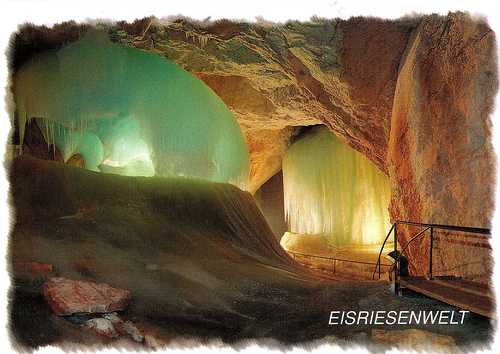

Location: Map
Open: May- Oct
Nearest town:
Werfen- 3 miles (5 km)
Transport: Car or train from Salzburg to Werfen than a bus to the car cable
Official site
Eisriesenwelt Ice Cave is located 40 km (25 miles) from Salzburg near town of Werfen some 5 km (3 mi) away. It is the largest accessible ice cave in the World with more than 40 km (25 miles) of exposed passageway. The uniqueness of this place is that stalagmites, and stalactites are made of ice that reaches 20 meters in depth in some places. Combined with waterfalls, pools and underground rives Eisriesenwelt offers an experience like no other. Odin’s Room, Hall of Hymir and Frigga’s Veil are some of the names that were given to cave features and take roots from the Nordic mythology. In fact the name of the cave " comes from German and means “World of the Ice Giants”.
The cave is located in the Tennengebirge above Wimm near Tenneck in
Austria, about 50 km south of Salzburg.
The urn of the researcher
Alexander von Mörk, who died in World War I and played a key role,
stands above a cave passage inside the cave, which extends 42 kilometers
into the mountain. Only the first kilometer is icy and can be visited
via a guide.
The entrance portal is 1640 m above sea level. A.
After the ice palace, there are no more connected ice plates, that's
where the guide part ends. A steep tunnel leads from the Ice Palace to
the U-Tunnel. After that comes the Midgards. This passage is the largest
in the cave (width between 8 and 30 meters). From there, there are
branches in all directions. The end of the cave is the New World at 1595
m.
The ice grows as a result of the chimney effect in the cave,
which transports cold air masses up to about 1 km into the cave interior
in winter. The rock stores the cold until spring and when it gets warmer
outside and the snow starts to melt, water can seep into the cave
through cracks and fissures in the rock and freeze to ice.
In
summer, the inside of the cave also warms up; 5–10 cm of the ground ice
cover melts away again. Everything grows back the following spring. All
in all, the ice isn't getting any less - it's getting a little more.
The cave was discovered in 1879 by the Salzburg naturalist Anton
Posselt. At that time he succeeded in penetrating about 200 m into the
interior of the cave. He couldn't go any further. The ice sheet grew too
steep for him; his equipment was too bad. He marked his turning point
with a black cross on the rock, the Posselt Cross. Afterwards the cave
was again largely forgotten.
In 1913, some researchers, Alexander
von Mörk, Erwin Angermayer and Hermann Rihl, succeeded in conquering the
steepest part of the ice sheet, the Great Ice Wall. Alexander von Mörk
was also the first researcher who dared to pass the Sturmsee, a small
passage that was under water at the time. Behind it he discovered a huge
hall, which was later named after him. In 1914 Alexander von Mörk had to
go into the First World War. There he fell at the age of 27. It was his
last wish to be buried in the ice giant world. His wish was granted and
he was buried in the Alexander von Mörk Cathedral he discovered in the
mid-1920s.
After the end of the First World War, the Salzburg
lawyer Friedrich Oedl (1894–1969) pushed research forward from 1919,
with the support of his brother Franz Robert Oedl and Leopoldine
Fuhrich. He built the first accommodation, the researcher's hut.
The landowners of the Eisriesenwelt are the Austrian Federal Forests.
The Salzburg Speleology Association had agreed a provisional lease with
them, which in 1928, after the founding of its own
Eisriesenwelt-Gesellschaft m.b.H. (whose first managing director was
Oedl) was converted into a long-term contract. Erwin Angermayer later
became managing director. The income is used for research and
development of the cave, the federal forests (as landowners) receive an
annual percentage of the entrance fees.
Development and tourism
The first guided tours in the
Eisriesenwelt took place in 1920. Today, a cable car takes up to 2,500
guests a day to the vicinity of the cave entrance (Dr. Friedrich Oedl
House), with around 150,000 visitors a year. Visitors are given carbide
lamps for the tour. The guides illuminate the approximately five ice
figures with magnesium light.
Visitors should note that the
ascent to the lower cable car station and from the mountain station of
the cable car to the cave entrance or with the 1400 steps (700 up and
700 down again) of the cave tour requires a certain level of fitness.
The tour lasts about 75 minutes. There is a ban on filming and
photography inside the cave, which is justified with feared delays and
their effects on the timing of the tours.
Today, the
Eisriesenwelt is usually open to visitors between May 1st and October
26th. In the winter months, the cave entrance cannot be reached due to
the high alpine location and the risk of avalanches. The temperature in
the cave mostly stays below freezing even in summer.